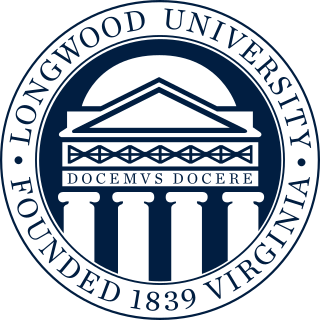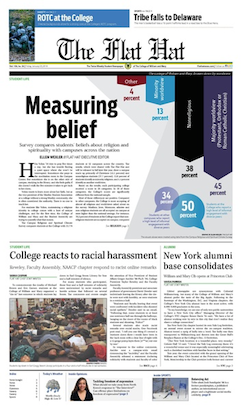
Williamsburg is an independent city in Virginia, United States. As of the 2020 census, it had a population of 15,425. Located on the Virginia Peninsula, Williamsburg is in the northern part of the Hampton Roads metropolitan area. It is bordered by James City County on the west and south and York County on the east.
The Phi Beta Kappa Society (ΦΒΚ) is the oldest academic honor society in the United States. It was founded at the College of William & Mary in Virginia, in December 1776. Phi Beta Kappa aims to promote and advocate excellence in the liberal arts and sciences, and to induct outstanding students of arts and sciences at select American colleges and universities. Since its inception, its inducted members include 17 United States presidents, 42 United States Supreme Court justices, and 136 Nobel laureates.

The College of William & Mary is a public research university in Williamsburg, Virginia, United States. Founded in 1693 under a royal charter issued by King William III and Queen Mary II, it is the second-oldest institution of higher education in the United States and the ninth-oldest in the English-speaking world. It is classified among "R2: Doctoral Universities – High Research Activity". In his 1985 book Public Ivies: A Guide to America's Best Public Undergraduate Colleges and Universities, Richard Moll included William & Mary as one of the original eight "Public Ivies". The university is among the original nine colonial colleges.

Longwood University is a public university in Farmville, Virginia. Founded in 1839 as Farmville Female Seminary and colloquially known as Longwood or Longwood College, it is the third-oldest public university in Virginia and one of the hundred oldest institutions of higher education in the United States. Previously a female seminary, normal school, and college, Longwood became coeducational in 1976 and gained university status on July 1, 2002.
The Bishop James Madison Society (BJMS) is a secret society of the College of William & Mary in Virginia. The society is best known through its Last Lecture Series, held each spring semester.

The Flat Hat Club is the popular name of a collegiate secret society and honor fraternity founded in 1750 at the College of William & Mary in Williamsburg, Virginia.

The Wren Building is the oldest building on the campus of the College of William & Mary in Williamsburg, Virginia. Along with the Brafferton and President's House, these buildings form the College's "Ancient Campus." With a construction history dating to 1695, it is the oldest academic building still standing in the United States and among the oldest buildings in Virginia. It was designated a National Historic Landmark in 1960.

The Flat Hat is the official student newspaper at the College of William and Mary in Williamsburg, Virginia. It prints Tuesdays during the College's academic year. It began printing twice-weekly in 2007; since its inception in 1911, The Flat Hat had printed weekly. It returned to weekly printing in 2015. In fall 2020, The Flat Hat began printing biweekly due to restrictions associated with the COVID-19 pandemic. The Flat Hat staff operates out of its office in William and Mary's Sadler Center.

James Blair was a Scottish-born clergyman in the Church of England. He was also a missionary and an educator, best known as the founder of the College of William & Mary in Williamsburg, Virginia.
There are many collegiate secret societies in North America. They vary greatly in their level of secrecy and the degree of independence from their universities. A collegiate secret society makes a significant effort to keep affairs, membership rolls, signs of recognition, initiation, or other aspects secret from the public.
The Virginia Informer was a student-run publication at The College of William and Mary in Williamsburg, Virginia. The newspaper contained five sections: News, Features, Sports, Arts & Culture, and Opinion. It was a member of the Collegiate Network and a member of the Associated Collegiate Press.
The Seven Society, Order of the Crown & Dagger is the longest continually active secret society of the College of William & Mary in Williamsburg, Virginia. The clandestine, yet altruistic group is said to consist of seven senior individuals, selected in their junior year. While, historically, graduating members formally announced their identities each spring, today's membership is steeped in mystery and is only revealed upon a member's death.

The history of the College of William & Mary can be traced back to a 1693 royal charter establishing "a perpetual College of Divinity, Philosophy, Languages, and the good arts and sciences" in the British Colony of Virginia. It fulfilled an early colonial vision dating back to 1618 to construct a university level program modeled after Cambridge and Oxford at Henricus. A plaque on the Wren Building, the college's first structure, ascribes the institution's origin to "the college proposed at Henrico." It was named for the reigning joint monarchs of Great Britain, King William III and Queen Mary II. The selection of the new college's location on high ground at the center ridge of the Virginia Peninsula at the tiny community of Middle Plantation is credited to its first President, Reverend Dr. James Blair, who was also the Commissary of the Bishop of London in Virginia. A few years later, the favorable location and resources of the new school helped Dr. Blair and a committee of 5 students influence the House of Burgesses and Governor Francis Nicholson to move the capital there from Jamestown. The following year, 1699, the town was renamed Williamsburg.
A number of secret societies operate at the College of William & Mary in Williamsburg, Virginia, dating back to the founding of the nation's first known collegiate secret society, The F. H. C. Society, founded on November 11, 1750. Today several secret societies are known to exist at the college, including Bishop James Madison Society, the Flat Hat Club, the Ladies of Alpha, the Live Oak Society, the Phi Society, the Seven Society, the Society, the 13 Club, the W Society, the Wren Society, and the Zodiac Society.

Saint Bede Catholic Church in James City County and Williamsburg, Virginia, is a Catholic parish in the Diocese of Richmond. The National Shrine of Our Lady of Walsingham, located adjacent to the campus of the College of William & Mary, is a part of the parish. It was the first Catholic church in Williamsburg.

The Williamsburg Bray School was a school for free and enslaved Black children founded in 1760 in Williamsburg, Virginia. Opened at Benjamin Franklin's suggestion in 1760, the school educated potentially hundreds of students until its closure in 1774. The house it first occupied is believed to be the "oldest extant building in the United States dedicated to the education of Black children".

The President's House is the residence of the President of the College of William and Mary in Virginia in Williamsburg, Virginia. Constructed in 1732, the building still serves its original purpose and is among the oldest buildings in Virginia. Since its construction only one of the college's presidents, Robert Saunders Jr., has not moved into the building, which is let for free to the president. The President's House is William & Mary's third-oldest building and the oldest official college presidential residence in the United States.

The Bodleian Plate is a copperplate depicting several colonial buildings of 18th-century Williamsburg, Virginia, as well as several types of native flora, fauna, and American Indians. Following its 1929 rediscovery in the archives of the Bodleian Library, it was used extensively in John D. Rockefeller Jr.'s reconstruction of Colonial Williamsburg. The plate has been tied to Williamsburg resident William Byrd II and may have been produced by English illustrator Eleazar Albin and engraver John Carwitham. It is dated to the 1730s.

Hearth: Memorial to the Enslaved is a memorial on the campus of the College of William & Mary in Williamsburg, Virginia. It was dedicated in 2022 to those enslaved by the university over a period of 172 years.

The College of William & Mary has maintained a campus in what is now Williamsburg, Virginia, since 1693. The cornerstone of the Wren Building, then known as the College Building and the oldest surviving academic building in the United States, was laid in 1695. The college's 18th-century campus includes the College Building, the President's House, and Brafferton–all of which were constructed using slave labor. These buildings were altered and damaged during the succeeding centuries before receiving significant restorations by the Colonial Williamsburg program during the 1920s and 1930s.














